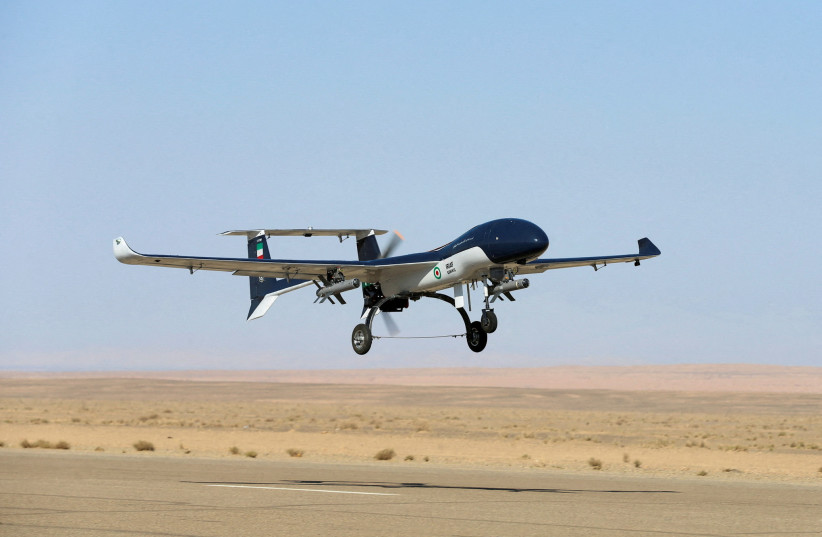US shot down an Iranian drone in broad daylight in Syria - analysis

This drone stands out because it was conducting surveillance. Is Iran thinking that it can send “objects” over US bases and outposts like China did with a balloon?
The US said it shot down an Iranian-manufactured drone in Syria on Tuesday. According to US Central Command, “On February 14, at approximately 2:30 p.m. local time, US forces in Syria engaged and shot down an Iranian-manufactured UAV attempting to conduct reconnaissance of Mission Support Site Conoco, a patrol base in northeast Syria.”
This is not the first time the US has had to contend with Iranian drone threats. Over the last several years, Iran has increasingly used drones and rockets to target US forces in Iraq and in Syria, with a special focus on the latter. The Tuesday incident stands out though – it occurred during daylight hours.
One analyst who self-describes as an “Iranian-American, OSINT [open-source intelligence]” expert, noted that “the drone shot... was very likely Yazdan.” The analyst, who goes by the name “Mehdi H” online, noted that “this hand-launched UAV was first unveiled in the Iranian Army Day parade on April 18, 2022... The Iranian Army used Yazdan UAV in the International Armies competition in Kazakhstan on Aug 2021.”
“The Yazdan’s range is reportedly 40 km. Iran has also developed a VTOL [vertical take-off and landing] version of the Yazdan UAV (quadcopter configuration) which was used in the Iranian Army UAV exercise on Aug 2022,” the analyst added.
This incident wasn’t ignored. Stars and Stripes, quoting Jeremy Binnie, an analyst at the defense intelligence firm Janes, noted that “the drone appeared to be a short-range surveillance aircraft hand-launched by forces nearby.”
Why does this Iranian drone incident stand out?
This drone stands out because it was conducting surveillance – not doing the usual Iranian kamikaze drone activity to target US forces and outposts, like it did in January at the Tanf garrison in Syria. Another Iranian drone was downed in Iraq by the US in September.
The Tuesday incident comes at a time when there is increased focus on Iran sending drones to Russia in its invasion of and war against Ukraine. This means that the surveillance drone could be a message to US forces – otherwise why fly it in the day in an area the US will obviously see it?
America has several hundred troops in eastern Syria, supporting the anti-ISIS mission of the Syrian Democratic Forces (SDF). Iranian militias and proxies based near the Euphrates River have often targeted US forces in eastern Syria, especially in the Conoco and Omar field areas.
The surveillance drone flagrantly flying in daylight also comes after China allegedly floated a large spy balloon over the US, after Washington said it downed “objects” over the US and Canada in recent weeks. Is Iran thinking that it, too, can send “objects” over US bases and outposts?
Countering drone threats is an increasing priority in the region overall.
Countering drone threats is an increasing priority in the region overall. Companies that produce defense tech to identify and counter drones – or what are called UAS (unmanned aircraft system) threats – are increasingly showing off their new technology at forums, such as the IDEX international defense exhibition that runs from February 20-24 in the UAE.
This means that all sorts of methods may be on display for the detection, tracking and identification of drones for states to acquire and counter threats made against them – like drones and unidentified aerial phenomena.
New technology could involve using lasers or microwave systems to counter drones, which can also be jammed or shot down with guns, missiles and even other drones. In some cases, rifles can be used to shoot them down, such as the precision fire Smart Shooter system. In other cases, countries may scramble jets or helicopters to counter drone threats.
Securing the airspace against these threats is an increasing issue; the US learned this in Iraq and Syria. The Iranian drone threat is now well known, as are its smuggling networks and nefarious methods used to try to export the technology around the region and to Russia.
This week, Iranian President Ebrahim Raisi visited China, likely looking for investment opportunities for his country’s drone programs. In addition, Iranian weapons shipments to Yemen have been intercepted recently.
This also all comes as Central Command and Israel have been doing joint drills, including the recently concluded Juniper Oak, and Juniper Falcon.
Jerusalem Post Store
`; document.getElementById("linkPremium").innerHTML = cont; var divWithLink = document.getElementById("premium-link"); if (divWithLink !== null && divWithLink !== 'undefined') { divWithLink.style.border = "solid 1px #cb0f3e"; divWithLink.style.textAlign = "center"; divWithLink.style.marginBottom = "15px"; divWithLink.style.marginTop = "15px"; divWithLink.style.width = "100%"; divWithLink.style.backgroundColor = "#122952"; divWithLink.style.color = "#ffffff"; divWithLink.style.lineHeight = "1.5"; } } (function (v, i) { });

